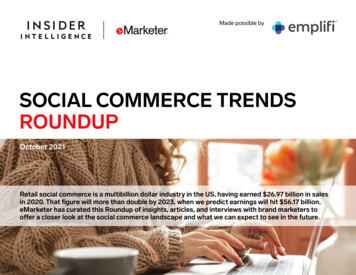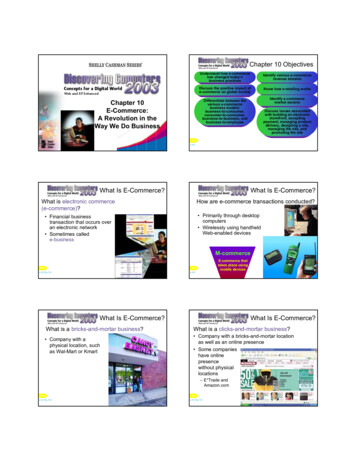
Transcription
Made possible bySOCIAL COMMERCE TRENDSROUNDUPOctober 2021Retail social commerce is a multibillion dollar industry in the US, having earned 26.97 billion in salesin 2020. That figure will more than double by 2023, when we predict earnings will hit 56.17 billion.eMarketer has curated this Roundup of insights, articles, and interviews with brand marketers tooffer a closer look at the social commerce landscape and what we can expect to see in the future.
TABLETEXT OF CONTENTS3Sponsor message4Overview5How US retail brands can take advantage of growing social commerce trends6US influencer marketing is now a 3 billion-plus industry8Livestream shopping catches on in the US10How important will livestreaming be for social commerce in 2021?12Social commerce: The new era of online shopping14Questions about TikTok’s new Shopping tab, answered15Quip's VP of growth talks D2C models, podcast ads, and making a toothbrush as cool as Nikes17Social commerce best practices for US brands18About this RoundupSOCIAL COMMERCE TRENDS ROUNDUPMADE POSSIBLE BY:2
SPONSOR MESSAGEWith the explosion of new social channels, brands are thinking hard about how to win thenext generation of customers. Without question, they will need to embrace conversationalcommerce, live shopping, and other forms of shoppable social media. They will also need toprovide in-the-moment support through a combination of chatbots, live agents, and digitalself-service.These developments require a different kind of platform for managing the customerexperience (CX) at scale—one that is unified and flexible enough to support increasinglycomplex customer journeys.For 25 years, Emplifi has been a leader in social media management and customer servicesolutions. With the acquisition of Go Instore earlier this year, we’re bringing live shoppingand livestreaming into our unified CX platform for enterprises. We’re on a mission to helpbrands close the CX gap and optimize digital interactions every step of the way.For more information, visit emplifi.io.SOCIAL COMMERCE TRENDS ROUNDUPMADE POSSIBLE BY:3
OVERVIEWRetail social commerce is already a multibillion dollar industry inthe US, having earned 26.97 billion in sales in 2020. That figurewill more than double by 2023, when we predict retail social commerce earnings will hit 56.17 billion.US Retail Social Commerce Sales, 2019-2025billions and % change 79.64A deeper dive: 67.32n Social commerce is most popular among adult members of Gen Z:More than half of US social media users ages 18 to 24 have madepurchases via a social channel. 56.17 45.74n While social buying is a growing trend in the US, it's more popular inChina and Russia, where 51.5% and 49.5% of social network usershave purchased via a social channel.38.9%25.2%n In the US, millennials are the most likely group to use social medianetworks as important information sources for shopping decisions.Looking ahead, we project social commerce will be a 79.64 billionindustry in the US by 2025. While that's a lofty figure, marketers have along way to go if they plan on catching up with China's success. 26.97 36.6235.8%24.9% 19.42201920202021Social commerce salesSocial commerce will be a 79.64billion industry in the US by 2025,according to eMarketer estimates.SOCIAL COMMERCE TRENDS ROUNDUP202222.8%19.9%18.3%202320242025% changeNote: includes products or services ordered via social networks (such as Facebook,Instagram, Pinterest, WeChat, Line, VK, and others) regardless of the method of payment orfulfillment; excludes travel and event tickets, tips, subscriptions, payments, such as bill pay,taxes or money transfers, food services and drinking place sales, gambling and other vicegoods salesSource: eMarketer, May 2021266527MADE POSSIBLE BY:eMarketer InsiderIntelligence.com4
HOW US RETAIL BRANDS CAN TAKE ADVANTAGE OF GROWINGSOCIAL COMMERCE TRENDSAlthough the US has begun to reopen post-pandemic, certaintrends that started during lockdowns will continue to grow thisyear. We expect US social commerce sales to rise by 35.8% in2021 to 36.62 billion, as noted in our June 2021 report, "SocialCommerce Forecasts 2021: How a Trend ‘Made in China’ IsShaping Up in the US."That’s only a slight deceleration in growth from 2020, when salessurged by 38.9% thanks to the pandemic-driven boom in ecommerce,increased social media consumption, and brands continuing to leveragethese platforms to sell directly to consumers.In 2022, the growth rate will dip back down to pre-pandemic levels andslowly decelerate through 2025. That said, the average amount spentby a social buyer in a year will double between 2020 and 2025, reaching 737.32 per buyer.As noted in our recent report, “US Ecommerce Forecast 2021,” althoughUS social buyers are not spending a lot as a whole, their average ordervalues are relatively high. As a result, brands should master socialmedia platforms to not only inspire consumers but also facilitate oneclick purchases.In 2021, we expect 90.2 million US people, or 35.9% of internet users,to make at least one social commerce purchase during the calendaryear. That puts the US in second place out of the 13 countries where weforecast social buyers, behind only China.Overall, we estimate that US social commerce will more than doublebetween 2021 and 2025, reaching 79.64 billion.Consumers are engaging with social platforms more, and theseplatforms are often used at different points of the shopping journey—from inspiration to purchase. Retailers and brands will need to includesocial media strategies in their playbooks to reach this coveted shopper.One tip for US brands that want to succeed in this space is to consideryour audience, as social commerce may not work for every customerbase. Gen Zers and millennials are the most likely generations to make apurchase via social media.According to our latest forecast, around half of US social network usersages 18 to 34 will make at least one social commerce purchase in 2021,compared with around one-third of those ages 55 and over.In brief, we define "social commerce" as purchases made by buyingdirectly on the social platform, such as via Instagram Checkout, orthrough clicking links on the social network that lead to the retailer’sproduct page to complete the transaction.SOCIAL COMMERCE TRENDS ROUNDUPMADE POSSIBLE BY:5
US INFLUENCER MARKETING IS NOW A 3 BILLION-PLUS INDUSTRYUS influencer marketing spending will rise by 33.6% in 2021 to 3.69 billion. Our inaugural forecast shows that US marketers willallocate nearly 1 billion more to influencer marketing this yearthan they did in 2020, representing the strongest spending growthin the industry since 2019. Growth will continue in double digitsuntil 2023, when spending on influencer marketing campaigns willapproach 5 billion.US Influencer Marketing Spending, 2016-2023billions and % change 4.62 4.14 3.6945.8%45.1%Improved brand-creator collaboration tools from social platforms.Recent examples include the following: 2.4233.6%n Instagram: In April, Instagram announced it would launch a creator 1.3226.4% 0.9014.4%2016201720182019Influencer marketing spending2020202112.2%11.5%20222023% changeNote: payments made to influencers or their representatives to promote products andservices primarily on social media and other platforms featuring user-generated content;excludes noncash payments such as free products or trips; excludes paid mediaSource: eMarketer, June 2021267827Instagram is the leading influencer marketing platform. While wedon’t publish platform-specific breakouts for influencer marketingspending, we estimate that Instagram accounts for roughly half ofthe market. A significant portion of spending also goes to influencercampaigns on YouTube and Facebook. TikTok is still a small slice of theinfluencer marketing spending pie, but it’s growing fast.What’s driving influencer marketing spending growth in 2021? 2.76 1.91The strong spending growth comes after a year of influencermarketing budget cuts. Close to two-thirds of US marketers workedwith influencer marketing last year, up from 55.4% in 2019. But as thepandemic put a strain on marketers’ budgets—particularly in the earlypart of 2020—many were forced to pause campaigns or cut influencers’paychecks, slowing spending growth. And many marketers who workedwith influencer marketing last year did so by amplifying influencercontent in their paid media campaigns. Our forecast excludes spendingon paid media campaigns with influencers.eMarketer InsiderIntelligence.comSOCIAL COMMERCE TRENDS ROUNDUPmarketplace to connect brands and creators for partnerships. Thatwas followed by a series of updates to its branded content tools,including the ability for creators to tag up to two businesses per pieceof branded content.n Snapchat: In May, Snapchat rolled out a new creator marketplaceto help influencers partner with businesses for branded content andLenses, Snapchat’s artificial reality filters.n TikTok: In January, TikTok launched the Creator Portal to providecreators with tools and advice on content strategy, including a directlink to its creator marketplace to help them set up partnerships withbrands. In June, TikTok also introduced TikTok Jump, which allowscreators to embed third-party services from brands into their videos.MADE POSSIBLE BY:6
—CONTINUEDn YouTube: YouTube revamped its creator marketplace in June 2020.Now called BrandConnect, the feature connects creators with brandsand provides tools to help embed products into videos and formarketers to measure the impact of their partnerships.These new tools enable marketers and creators to work together moreseamlessly, pushing more spending into the influencer marketing space.The rise of social commerce. From shoppable content to livestreamingcommerce, brands are increasingly tapping creators to help drive theirsocial commerce goals. As influencers prove their ability to drive sales aswell as brand awareness, we expect brands to invest more money intoinfluencer marketing. According to our latest forecast, 90.2 million USconsumers ages 14 and up, or 35.9% of internet users, will make at leastone purchase via social media during 2021.According to our latest forecast,90.2 million US consumers ages 14and up, or 35.9% of internet users,will make at least one purchase viasocial media during 2021.Influencers will continue to rely on brand sponsorships. Creators havemore ways than ever before to make money, but brand sponsorships willremain the primary source of income for most. As creators continue torely on brands for their livelihoods, more money will flow into influencermarketing. And as social platforms continue to incentivize creatorsto create content for their platforms, more opportunities for brandcollaborations will open up. Facebook, for instance, recently pledged toinvest over 1 billion in creator programs by the end of 2022 in an effortto attract and retain creators on its core platform and Instagram.How does influencer marketing spending compare with socialnetwork ad spending?The continued growth of TikTok. Even as TikTok and other short-videovenues work toward developing their ad businesses, influencer marketingcontinues to be the primary way for brands to engage with thoseaudiences. And, as brands ramp up their own ad and organic contentproduction on those platforms, they’re also willing to pay influencersfor their help. Case in point: the launch of IPG Mediabrands’ CreatorCollective, which matches clients with creators to provide feedbackand advice on campaigns, and ATTN:’s TikTok studio, which providesconsulting and creative and production services for brands.SOCIAL COMMERCE TRENDS ROUNDUPThe return of travel and influencer marketing adoption among newindustries. Pandemic-related travel restrictions and social distancingmeasures disproportionately affected travel influencers, many of whom wereforced to pivot their strategies and collaborate with different kinds of brands,like finance and consumer packaged goods. (Think travel influencerspartnering with credit card companies that offer cards with travel perksfrom online shopping.) As travel marketing returns and those new industriescontinue to spend, total influencer marketing spending will rise.Influencer marketing spending is a drop in the bucket whencompared with social network ad spending. In 2021, we expectUS advertisers will spend 58.66 billion on social network ads, up by26.9% year over year. But both influencer marketing spending and socialnetwork ad spending are rising in tandem, indicating a growing relianceon social media overall.Influencer marketing is helping propel social network ad spending.Amplifying influencer content via paid media accelerated during thepandemic, particularly in the early days as studio closures and budgetaryconstraints curtailed ad content creation. Since then, marketers havecontinued to rely on the tactic as it proved to be a quick, easy-to-produce,and inexpensive alternative to brands’ own creative. That will help drive adspending growth on social platforms, as we count spending on those paidmedia campaigns in our social network ad spending estimates.MADE POSSIBLE BY:7
LIVESTREAM SHOPPING CATCHES ON IN THE USPopularized in China, livestream ecommerce combines QVC-likeshopping, game shows, talk shows, and auctions with the ability tochat and purchase in real time.China’s livestream shopping market alone is bigger than everyother country’s total ecommerce market—save two. Livestreamshopping took off in China four to five years ago, but has developedinto a 300 billion industry this year, accounting for 11.7% of all retailecommerce sales in the country. To put that in perspective, that figuremakes the livestream shopping market in China larger than every otherentire retail ecommerce market in the world, except for China andthe US.The phenomenon gained momentum in the US last year. In the US,livestreaming was just starting to make inroads when the pandemic hit,giving it a sudden boost. Brick-and-mortar stores temporarily closeddown and consumers, quarantined at home, looked for new ways toentertain themselves and shop.US brands are turning to partners for their livestream shoppinginitiatives. Livestreaming remains a relatively nascent shoppingexperience in the US. But smaller, more daring digitally native brands,and even well-established brands and retailers, are testing the waters.Most are partnering with one of four types of players:n Social media networks. Many brands are using the massive existingaudiences of social media networks and their expanding livestreamofferings. Walmart’s partnership with TikTok and Sephora’s withFacebook are just two examples of this practice.n Newer livestream shopping apps. A number of new apps haveemerged that offer brands the opportunity to livestream on theirplatform. Brands like Diageo and Vans have partnered with LA-basedNtwrk; Ulta Beauty has worked with beauty-focused Supergreat.Livestreaming Ecommerce Sales in China,2019-2023billions, % change, and % of total retail sales 623.29218.5% 479.46160.0% 299.66 161.9885.0%60.0%30.0% vestreaming ecommerce sales% of total retail ecommerce sales% changeNote: includes products or services ordered via online video streaming where the presenterdemonstrates and discusses the offering and answers audience questions in real time; thelivestream session can take place on an ecommerce website or on a social media platform;includes products or services ordered using the internet via any device, regardless of themethod of payment or fulfillment; excludes virtual items gifted by viewers to livestreampresenters, travel, and event ticketsSource: eMarketer, May 2021266548eMarketer InsiderIntelligence.comn Legacy home shopping networks. Many established brands havelong-standing relationships with legacy home shopping players likeQVC or HSN (now both part of Qurate Retail Group). For example,SOCIAL COMMERCE TRENDS ROUNDUPMADE POSSIBLE BY:8
—CONTINUEDEstée Lauder and Dyson sell through QVC. These legacy TV networksare well-established shopping platforms built around video; they enjoyhigh levels of brand recognition. However, buyers on these platformscan skew older than those on digital platforms.n Amazon. In 2019, Amazon launched Amazon Live, a series ofconcurrent livestreams where brands can showcase their products.Livestreams appear on Amazon product detail pages and on theAmazon Live homepage. However, Amazon Live hasn’t gained serioustraction, with even the featured livestream often attracting a fewhundred shoppers at most.Livestream shopping took off inChina four to five years ago, but hasdeveloped into a 300 billion industrythis year, accounting for 11.7% of allretail ecommerce sales in the country.Going it alone is also an option. Retailers such as Nordstrom have alsolaunched their own livestream shopping channels. This approach allowsretailers to retain complete control of the experience and tap into loyalshoppers. But it’s difficult for retailers to get a large number of shoppersto tune in to livestreams. New channels like these have to be marketed toreach relevant shoppers.Brands and retailers should choose a strategy based on their tech knowhow and target demographics. But they should bear in mind that thelines are blurring—even established brands like QVC are wooing youngercustomers with their digital-first initiatives.SOCIAL COMMERCE TRENDS ROUNDUPMADE POSSIBLE BY:9
HOW IMPORTANT WILL LIVESTREAMING BE FOR SOCIALCOMMERCE IN 2021?Livestreaming was an existing trend that gained newfoundrelevance during the pandemic. Over the past few months, nearlyall of the major US social networks have expanded their servicesand introduced new livestreaming opportunities, many of whichare aimed at boosting commerce on the platforms.US Adults Who Have Watched a Livestream ofSomeone Talking About a Product that They MightWant to Buy, April 2021% of respondentsYes, and I ultimately bought the productbased in part on their recommendation7%Here are some of the key developments:n Facebook: In May 2021, Facebook introduced “Live ShoppingFridays,” during which brands can showcase products throughFacebook’s live shopping feature. From the livestreams, customerscan tap featured products to learn more about them, add products totheir shopping carts, and check out.n Instagram: The platform first introduced live shopping capabilitiesfor merchants that use its in-app payment system, InstagramCheckout, in May 2020. In March 2021, Instagram expanded itslivestreaming offering with the launch of Live Rooms, which allowusers to add up to three other co-hosts to their livestreams, doublingthe number of hosts per livestream from two to four.Yes31%No62%n Pinterest: In late May 2021, Pinterest hosted its first in-applivestreaming event with an initial test group of 21 creators as hosts.Viewers were able to shop products promoted in the livestreamsessions via Product Pins and comment to interact with the hosts.n TikTok: In March 2021, Walmart partnered with TikTok for a secondlive shopping event on the platform, following a pilot of the livestreamshopping program in December 2020. Walmart hasn’t provided salesfigures from the first live event but told TechCrunch in March that itreceived seven times more views than expected and a 25% increasein its TikTok follower count.Note: n 2,024 ages 18 Source: The Harris Poll, "Covid-19 Wave 60," April 19, 2021265462eMarketer InsiderIntelligence.comThe social platforms have had no trouble getting brands to buy intotheir live shopping ambitions—Facebook’s Live Shopping Fridays, forexample, boast many big-name brands from Sephora to Abercrombie &Fitch. The networks’ enthusiasm for live shopping comes directly fromSOCIAL COMMERCE TRENDS ROUNDUPMADE POSSIBLE BY:10
—CONTINUEDChina, where livestream shopping is already big business for brands.In April this year, for instance, ecommerce giant Alibaba revealed that itgenerated 61.7 billion in gross merchandise value (GMV) in 2020 on itsTaobao livestreaming platform for merchants alone and that the numberof daily active users on the platform doubled from 2019.In April this year, ecommerce giantAlibaba revealed that it generated 61.7 billion in GMV in 2020 on itsTaobao livestreaming platform formerchants alone, and that the numberof daily active users on the platformdoubled from 2019.Overall, we expect total retail livestreaming ecommerce sales in Chinato reach 299.66 billion in 2021, including livestream sessions on bothecommerce and social media platforms. The total number of livestreamecommerce buyers in China will hit 320.1 million—of which 60.7%, or194.2 million, will make a purchase via a livestream on social media atleast once this year.In the US, buying products promoted via livestreams is still in its earlydays. In an April 2021 survey by The Harris Poll, for example, 38% ofUS adults said they had watched a livestream of someone talking abouta product that they might want to buy, but just 7% said they ultimatelybought the product based on the presenter’s recommendation.But interest is rising, and livestreaming is poised to be a major driverof growth for social commerce as the capabilities expand and improve.In a Q4 2020 survey by GlobalWebIndex, for instance, 22% of US andUK social livestreamers said having a “buy” button available during alivestream session would be a top purchase driver, compared with 13% ofsocial network users who said the same for social media content overall.According to our inaugural forecast, livestreaming social commercesales in China will reach 131.52 billion in 2021 and account for 37.4%of total social commerce sales in the country. By 2023, 60.9% of socialcommerce dollars in China will come from livestream shopping, amountingto 281.21 billion.SOCIAL COMMERCE TRENDS ROUNDUPMADE POSSIBLE BY:11
SOCIAL COMMERCE: THE NEW ERA OF ONLINE SHOPPINGThis article was contributed and sponsored by Emplifi.Zarnaz ArliaCMO, EmplifiSocial commerce is taking the businessto-consumer (B2C) world by storm. Ifyou haven’t bought something directlythrough Instagram, Facebook, or TikTokstorefronts, you will soon. eMarketerestimates that social commerce will bea 351 billion industry this year in China alone, and it’s growingrapidly in Europe and the US, too.Not surprisingly, the leaders are B2C brands in industries like apparel,consumer electronics, cosmetics, and home décor. Consider theseexamples from established global brands:(CX) gap—the distance between what consumers expect from theironline shopping experiences and how well brands are able to providethese experiences.Unmet CX needsBefore the market can realize all this promise, we must address severalunmet needs. Brands must avoid becoming a commodity, while learninghow to capture the next generation of consumers and turn followers intocustomers. Social media usage continues to grow, making it increasinglycrucial for brands to become discoverable and find ways to driveconversions via their social media presence.n Levi’s and Tommy Hilfiger have started experimenting with liveHow will marketers know which channels are going to be most effective?And will it be possible to add more channels without needing moreresources from IT? In each of these cases, solving the problem comesback to building relationships through exceptional CX.n Estée Lauder introduced livestream beauty tutorials for customersToday, most early adopters are making do with one-off integrations foreach channel and their ecommerce websites. More complex integrationsare emerging that connect to inventory management systems andproduct information systems.online shopping events hosted by influencers and celebrities, asan innovative way to embrace emerging technology and introducewhat’s new.to “watch & shop,” and a page of archived sessions inviting visitors tobinge watch past livestreams.Overcoming the challenges of social commerceSocial commerce has the potential to reinvent how brands engagecustomers at a key time in their journeys. From image shoppingto product demonstrations to discussions with a real salesperson,livestream shopping is bringing influencers, superusers, and peerstogether with shoppers to deliver the future of commerce. Connie Chanof a16z calls this phenomenon “shopatainment”—a combination ofentertainment, commerce, and content.In the not-so-distant future, companies will want to see lightningfast consumer connections, conversions, and sales across familiarsocial channels without the need for heavy information technology(IT) involvement. They will need a fully integrated way to manage andoptimize inventory across new channels, and have the means to providecare, help, information, and support through the same platform. Finally,omnichannel analytics and content management will be critical tosuccess in social commerce.This is a defining trend of our time and an opportunity for companiesto reach new audiences and delight them with the kind of memorable,convenient, and engaging experiences they seek. Embracing socialcommerce will be a critical strategy for closing the customer experienceOur increasingly social world needs a unified CX platform to bringtogether marketing, commerce, and care in a way that ushers in the newera of social commerce.SOCIAL COMMERCE TRENDS ROUNDUPMADE POSSIBLE BY:12
Turn social browsersinto social buyers.Close your CX gapClick this ad to learn how »emplifi.io
QUESTIONS ABOUT TIKTOK’S NEW SHOPPING TAB, ANSWEREDTikTok and Shopify are expanding their partnership. SelectShopify merchants worldwide are able to create in-appstorefronts in a dedicated Shopping tab on their TikTok profiles,the companies announced in late August.How does this feature compare with TikTok’s past social commerceupdates? The new Shopping tab changes the interface of the app itself,encouraging a new user behavior to emerge.n Many of TikTok’s social commerce features so far have centered onbuilding ecommerce-related ad products. But because TikTok adsappear as native videos on users’ For You feed, they don’t alter theexisting behavior of scrolling through videos.n The Shopping tab, on the other hand, encourages users to goto business profiles to make a purchase. Once there, users arepresented with a type of content they haven’t yet seen on TikTok:static product showcases.n As for in-app purchasing, for now, businesses will need to link usersout to their Shopify pages to complete the checkout process. ButDouyin, too, started off by linking out to Taobao stores before addingnative checkout.Will this development change our social commerce forecast?Though the TikTok Shopping tab is big news, Nazmul Islam, eMarketerforecasting analyst at Insider Intelligence, said our estimates still hold.n “The partnership with Shopify shouldn’t change the numbers toomuch—we set high growth levels expecting more developments insocial commerce,” Islam said.n Plus, he said, “clicking on ads is still the main way people end upn While it’s a big step forward for TikTok’s social commerce push, itcould also be a challenge. TikTok has become well known for twothings: short-form video, and the algorithm driving its time-suckingFor You feed. Getting users to engage with still-image productcatalogs may be a leap, but it’s one chance TikTok needs to take tokeep up with competitors.How does TikTok’s Shopping tab stack up against Instagram’sShop feature? There’s still no way to search for products, or to checkout natively, but both those things could change soon.n On Instagram, the Shop tab is accessible via the navigation bar, butshopping on TikTok is confined to businesses’ profiles. There stillisn’t a central place on TikTok to search for specific items or discovernew ones.n Even so, Instagram also started off with business profile-onlyshopping, before adding a dedicated Shop tab.n Plus, TikTok’s Chinese counterpart, Douyin, has let users search forSOCIAL COMMERCE TRENDS ROUNDUPproducts since 2019, so it’s likely something similar could come toTikTok soon.making purchases that count toward our social commerce salesnumbers.” Because there still isn’t a central discovery mechanism fornew brands or products, businesses will likely continue to rely on adsto drive users to their shops.n Notably, our forecast doesn’t touch on one major way TikTok drivespurchases: viral products that users search for and purchase off-site,a phenomenon known as “TikTok made me buy it.”What should marketers look out for? Pay extra attention to how usersengage with shopping-related content, and keep a close eye on whenthe feature ropes in more creators.n For now, TikTok is going slow—and for good reason. (Just think of thebacklash Instagram received when it put its Shop tab front and centerin users’ navigation bars.) Marketers should follow TikTok’s lead.n One big sign of success will be if TikTok expands the Shopping tab tocreators beyond existing Shopify merchants with TikTok For Businessaccounts. Not only will that open up a host of new influencermarketing opportunities, but it could also pull in some creators whohave been lured by Instagram’s more developed shopping features.MADE POSSIBLE BY:14
QUIP'S VP OF GROWTH TALKS D2C MODELS, PODCAST ADS, ANDMAKING A TOOTHBRUSH AS COOL AS NIKESShane Pittson is the vice president of growth at oral-careprovider Quip, overseeing advertising efforts and consumerresearch, optimizing lifetime value and customer acquisitioncosts, and improving retention rates. We recently spoke withPittson about creating buzz for a brand, gaining retail distribution, Quip's brief stint on dating apps, and more.people who don't want to shop online. So, I think moving into storeswas always part of the plan. But starting as D2C-only, I think itallowed us more flexibility in many ways and ultimately allowed us toenter conversations with retailers that had large-scale distribution,bringing with us more interesting data and perspectives to informthose conversations.Why do you think Quip has bee
17 Social commerce best practices for US brands 18 About this Roundup. SOCIAL COMMERCE TRENDS ROUNDUP MADE POSSIBLE BY: 3 With the explosion of new social channels, brands are thinking hard about how to win the . "US Ecommerce Forecast 2021," although US social buyers are not spending a lot as a whole, their average order values are .










